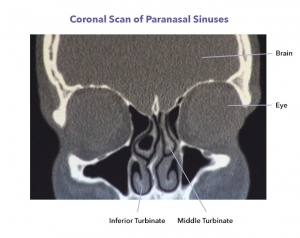Turbinate surgery

Surgery on the nasal turbinates may be performed in isolation however is frequently performed in conjunction with Septoplasty or Sinus Surgery.
What are Turbinates?
On each side of the nose there are three turbinates, superior middle and inferior. These are bony fins projecting into the airway. It is most commonly the inferior turbinates that causes issues with the nasal airway. Occasionally the middle turbinate is enlarged, as in the scan on this page, and may need to be dealt with as well.
The inferior turbinate is covered with rich vascular tissue. Its function is to warm and humidify the inspired air. It projects from the side wall of the nasal cavity low down and extends the full length of the nasal cavity.
Indications for turbinate surgery
The principal indication for surgery on the turbinates is nasal obstruction due primarily to enlargement of the inferior turbinate. Typically nasal obstruction due to the inferior turbinates is worse at night and may often swap from side to side with changes in position. When lying flat the nose is no longer above the heart resulting in increased venous pressure in the head and neck and less efficient drainage of blood from the inferior turbinate.
The operation
The most common turbinate operation is endoscopic powered sub mucus resection of the inferior turbinate. There are no external incisions and the procedure is done through the nostrils using fine endoscopes and a camera. Using a micro debrider that shaves the tissues, the under surface of the inferior turbinate is removed along with a portion of the bone. The remaining turbinate is rolled on itself thereby decreasing its bulk and pushing it to the side. This results in an improved airway but preservation of the functional surface that warms and humidifies the air. A light pack is left in the nose overnight to help with bleeding.
After surgery
The first night
An overnight stay in hospital is normal after the surgery. It is not uncommon to have a small amount of bleeding on the first night. Pain is not normally a major feature.
Discharge from hospital
Around 7 AM the following morning the nursing staff will remove the packs. It is not uncommon to have a slight bleed at this point. I will do a ward round at 730 AM to make sure all is well. Providing there are no concerns with bleeding or nausea, discharge home will normally occur mid-morning.
Diet
Following nasal surgery it is best to avoid food and drinks that are too hot as they may increase bleeding. A cool to warm normal diet is satisfactory.
Activity
Because the nose is such a vascular structure excessive physical activity may provoke bleeding. I therefore suggest that strenuous physical activity is avoided for two weeks.
Pain relief
Pain is not normally excessive following nasal surgery.
Surgery on the nose does however result in the release of natural compounds called inflammatory mediators. These are the same compounds that are released in viral infection and it is not at all unusual to have symptoms similar to a virus, such as lethargy and headache.
Paracetamol is normally sufficient however Palexis or similar is also prescribed in case it is required. Nurofen should not be used.
Other medications
Salt-water nasal sprays or douches are also provided and help clear some of the mucus and congealed blood.
Nose blowing
It is best to avoid nose blowing from the first few days as excessive or vigorous nose blowing may precipitate bleeding. Thereafter the nose may be blown gently, both nostrils open at the same time.
Nasal obstruction
It is normal to have some nasal obstruction for several days to a week following turbinate reduction. This is due to swelling and congestion in a confined space. Sleeping with the head elevated may help to some degree.
Bleeding
It is normal to have bloody mucous discharge from the nose or an occasional small fresh bleed for a few days after the operation. If bleeding is heavy or prolonged you should contact me.
Postoperative instructions
You will be given instructions for care upon discharge. These are also available to download here. At discharge you will also be given a post-operative appointment and my mobile phone number.